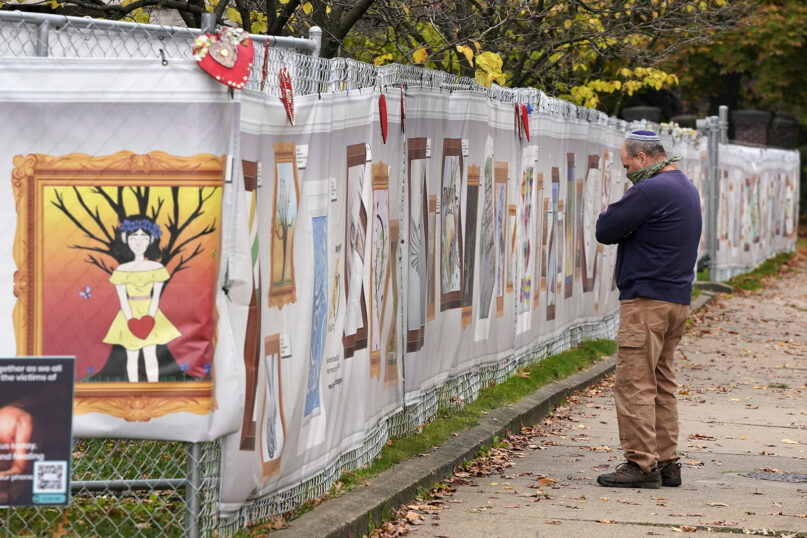(RNS) — In the days after the Tree of Life shooting two years ago, the response was similar to what it was in Las Vegas, Sutherland Springs, San Bernardino and so on. Vigils were crowded to overflowing, strangers embraced and wept, funerals were packed. Lines that normally mapped out the city’s different communities were ignored, and Muslims, Sikhs, Christians and Jews, Black Pittsburghers and white, mourned together.
A man who had already made thousands of white crosses for shooting victims drove from Illinois and planted 11 of them with Stars of David affixed. A logo was drawn up, T-shirts made. The city promised not to back down.
There is a template now, a crowdsourced manual: The incoming reporters are already familiar with the gun laws, the Justice Department with the grieving process, the mayors with the ways to commemorate, having learned from the experiences of their fellow chief executives in Orlando, Parkland, Newtown … the list went on, and has gone on since, and it will go on.
Still, when you report on these things over and over, as I have as a correspondent for The New York Times, you become attuned to the differences.
RELATED: Two years after Pittsburgh shooting, solemn anniversary marked online
In Charleston, where a white supremacist killed nine people at a Bible study at the Mother Emanuel Church, the reaction was different from what had come before. Yes, there was a template for grieving that horror, too. But it was a very old one, long kept but largely hidden from the eyes of white society, updated again and again and again.
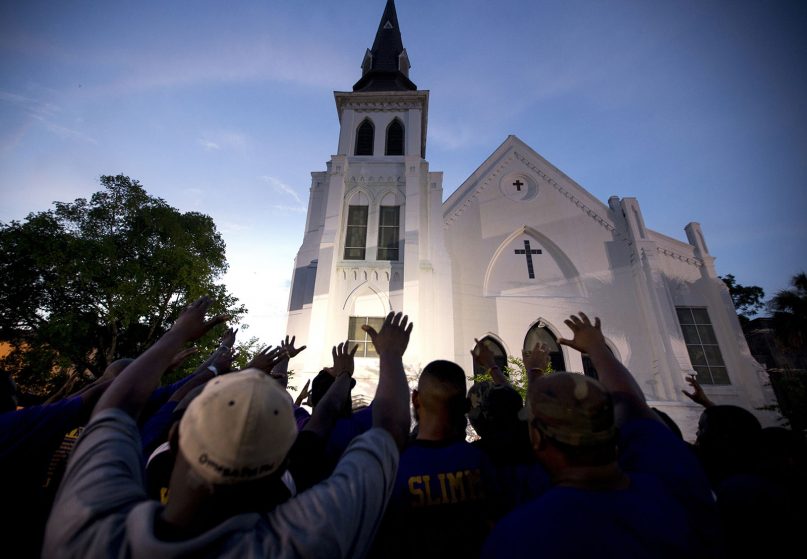
The men of Omega Psi Phi Fraternity Inc. lead a crowd of people in prayer outside the Emanuel AME Church on June 19, 2015, after a memorial in Charleston, South Carolina. (AP Photo/Stephen B. Morton)
Violence is by its nature shocking, but white supremacist violence in particular, in this country, is apple-pie familiar. What had happened at Mother Emanuel on a June night in 2015 fit onto a clear timeline that went straight back to the execution of church members in 1822 for allegedly plotting a slave rebellion, and went on long before that, too.
Everyone understood this, even if they tried to deny it. It’s still unknown what prompted the Las Vegas shooting, but as soon as you heard about Charleston, there wasn’t any doubt. What was worse: a mass killing that made no sense at all, or one that did?
My wife is Jewish. I’d gone to years of Passover Seders and mumbled gamely along to the Hanukkah blessings that my older daughter knew by heart by the time she was 5. But I came from a family of devoted Baptists; the basic wiring is different. How you react to suffering, how you see your duty to respond, who has the duty to forgive, to what degree you feel that pain is inevitable, all of this is in the genetics of a person’s faith, more nature than nurture. I have my instincts here and I don’t see myself abandoning them.
Still, my wife’s were formed by priests in the temple of Solomon at the same time that my own ancestors, as Benjamin Disraeli put it to the Irishman, were “brutal savages in an unknown island.”
Not long after the shooting I was walking through Squirrel Hill to a press conference a couple of blocks from the synagogue, stopping people on the sidewalk for short interviews.
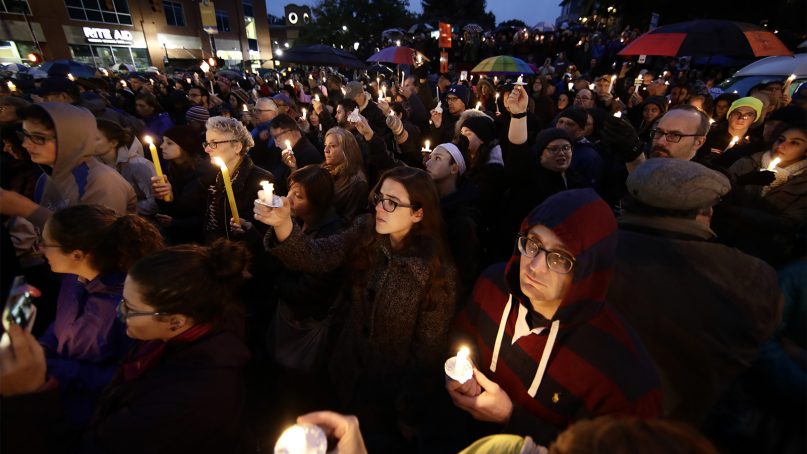
People hold candles as they gather for a vigil in the aftermath of a deadly shooting at the Tree of Life Congregation, in the Squirrel Hill neighborhood of Pittsburgh, on Oct. 27, 2018. (AP Photo/Matt Rourke)
Many were returning from services and, without phones on the Sabbath, familiar with only the vague details of the morning, asking whether I had heard the whereabouts of this or that person (though by and large the Jewish community of Squirrel Hill would know the precise toll long before the reporters did, because it was known who showed up at the JCC that afternoon and who didn’t, who always showed up early to services at Tree of Life and who didn’t).
They talked of the anti-Semitic episodes around Pittsburgh in years past, hate murders that took place 32 and 18 years earlier, but also acts of vandalism, one-off assaults, things that at the time had seemed like outliers.
Things in the country were getting ugly, an older man said, his wife nodding slowly beside him. Echoes of what family members who had come over from Europe used to talk about. As terrible as this horror was, it might well be a vanguard of horrors to come.
This was said with something like self-reproof: Of course, this is the way of things; comforting and familiar as Squirrel Hill is, it is not apart from the world, it was naïve to think otherwise.
I had never heard this kind of talk after other shootings, even Charleston. The talk this time was not of the return of some vile past, but of an age that never fully leaves, a darkness that inevitably comes back around again and again, the eternal recurrence of history. At other crime scenes one always heard that things in the country seemed to be coming apart; here it was that things, terrible things, might once again be coming together.
The following Wednesday was rainy and dreary. Little Spidermen and princesses carrying the spoils of trick-or-treating hustled along wet sidewalks past the people heading to the JCC for one of the week’s shivas.
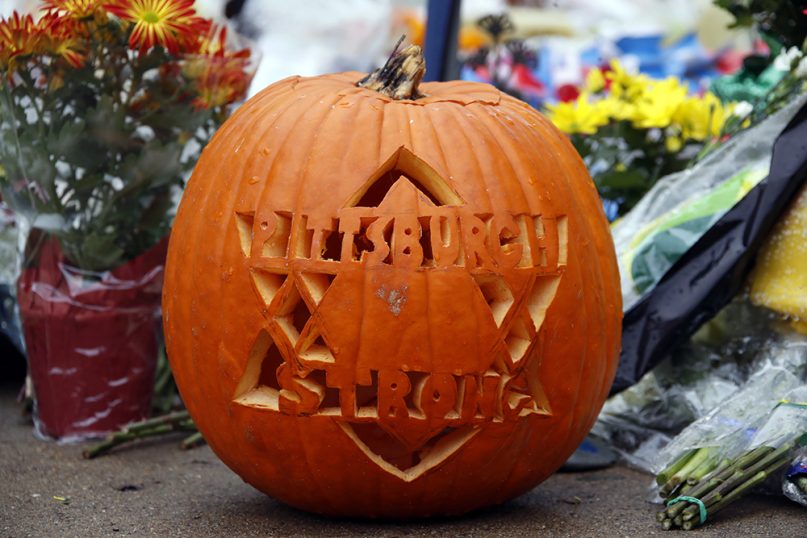
A pumpkin carved with the message “Pittsburgh Strong” sits among flowers outside the Tree of Life synagogue, on Nov. 1, 2018, as part of a makeshift memorial dedicated to those killed while worshipping at the synagogue on Oct. 27 in the Squirrel Hill neighborhood of Pittsburgh. (AP Photo/Gene J. Puskar)
By then, some order had settled in Pittsburgh. The funerals were being held, two or three a day, and a giant multicolored cairn had begun growing at the intersection of Wilkins and Shady Avenues, tributes sent in from around the world.
The president had come and gone, to the city’s vociferous disapproval, and the day before the president’s visit, the loner who had caused all of this had appeared, doughy and dispassionate, for a court hearing.
It was a perfunctory appointment, brief and before a mostly empty courtroom, though two members of Dor Hadash sat quietly in the gallery. “To witness,” one of them said to me in the hallway afterward. “That’s part of Jewish theory, to witness and remember.” Here it was, the ancient model of how to grieve, the template.
Pittsburgh had thankfully broken one part of the usual pattern, the part about how the gentiles behaved. The city had wrapped its arms around the Jewish community. This had virtually never followed violent anti-Semitism in its long, long history. The store windows on Forbes Avenue, from the Dunkin’ Donuts to the Chinese noodle shops, were billboards of love and support — in another time, as I heard observed more than once, what happened to glass windows in Jewish neighborhoods would have been very different.
Away from gentile eyes, the old template was carried out, with the chevra Kadisha — those who wash the dead and prepare them for burial — collecting blood at the crime scene and the recital of the mourner’s kaddish at nearly a dozen gravesides. Shivas unfolded, one starting after another after the one before that, like a funereal fugue.
The shiva on Halloween night was for Dr. Rabinowitz, one of the most extraordinary men I’ve ever heard about. I had gotten to know him only in conversations and news articles after his death, seeing photos of his bow tie and kind smile, learning among many other things that he had helped men suffering from AIDS in the days when few else would.
I sat quietly toward the back of a meeting room as friends and family stood up front and talked about Dr. Rabinowitz, but also about what had happened in a way that was, to me, surprisingly frank, stripped of false comfort.
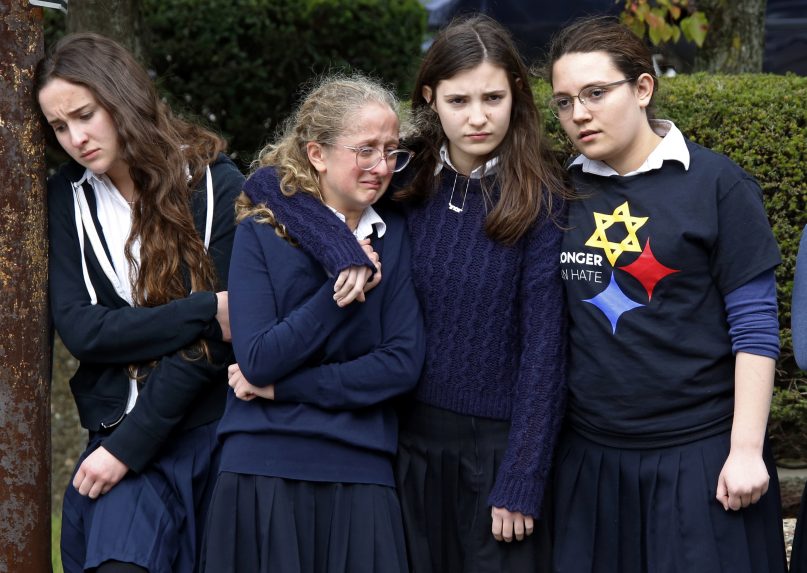
Students from the Yeshiva School in the Squirrel Hill neighborhood of Pittsburgh pay their respects as the funeral procession for Dr. Jerry Rabinowitz passes their school en route to Homewood Cemetery after a funeral service at the Jewish Community Center on Oct. 30, 2018. Rabinowitz was killed while worshipping at the Tree of Life synagogue on Oct. 27, 2018. (AP Photo/Gene J. Puskar)
The story from the Talmud was told about Adam and Eve and the first sunset: how they believed that the darkening of the world meant a return to chaos and the coming of death, how they spent the long night weeping together, how with the breaking of dawn Adam came to realize that this, in fact, was the order of the world, that light is followed by darkness and darkness by light.
I slipped out of the room not long after, walked past the wet and shiny trick-or-treaters, and I sat in my car in the dark, almost in a daze.
Right now, the phrase of the moment is social distancing. You never know who you are walking among, who is carrying a lethal pathogen, no matter how familiar your surroundings or routine the errand. Gathering for shul on an ordinary Saturday morning, for example. The courier of your death can show up anytime, anywhere.
But the main reason for social distancing is so the hospitals are not overwhelmed. The idea is to slow and spread out the outbreak so that those who are most in need of help are able to get it before the hospitals collapse. The whole system is terrifyingly vulnerable. Keeping it afloat, so it’s there when we one day need it ourselves, requires a hyperconsciousness of everyone around us.
You can go through life thinking you are at a safe distance from the dangers of the world, or from the suffering of strangers, but in either case you are perilously deluded.
On the last day before things started shutting down for the coronavirus, I drove my daughter to school. I thought about Dr. Rabinowitz and about the midrash: Darkness falls everywhere when the sun sets; when it’s night at the synagogue, it’s just as much night in the alley across the street. But the dawn comes everywhere, too.
(This article is adapted from “Keith Way” by Campbell Robertson from “Bound in the Bond of Life: Pittsburgh Writers Reflect on the Tree of Life Tragedy,” edited by Beth Kissileff and Eric Lidji. © 2020. All rights are controlled by the University of Pittsburgh Press. Used by permission of the University of Pittsburgh Press. The views expressed in this commentary do not necessarily represent those of Religion News Service.)
